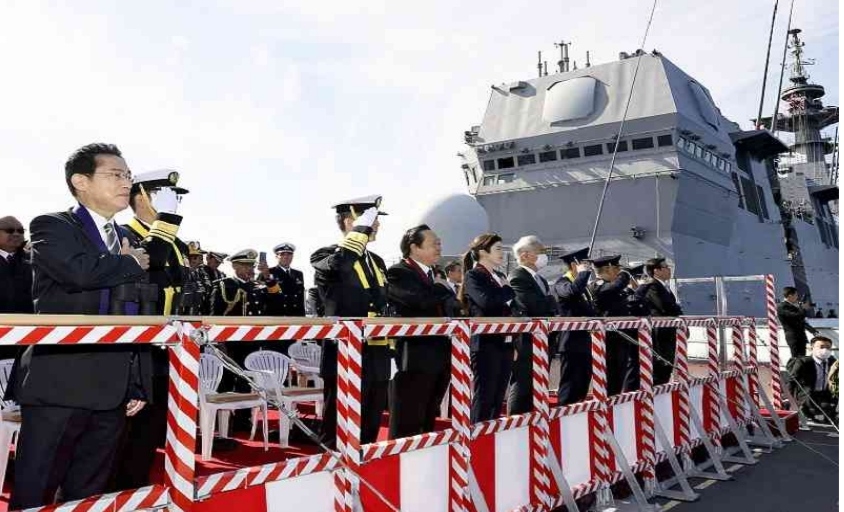Japan’s defense policy evolves as its security environment changes

Prime Minister Fumio Kishida, left, is seen aboard the Maritime Self-Defense Force destoyer Izumo in Sagami Bay.
By
Satoshi Ogawa
Japan is going to possess counterstrike capabilities. This policy change will be officially declared in the upcoming revision of the National Security Strategy later this month. Does this mean Japan is discarding its famous exclusively defense-oriented policy?
The answer is no. Since the end of World War II, Japan has evolved its security policy on the basis of its surrounding security environment. Now, in the face of China’s and North Korea’s military expansion, it has decided to strengthen its own deterrence by changing the policy regarding counterstrike capabilities, but without contradicting previous constitutional interpretations.
The extent of Japan’s defense capabilities is restricted by the Constitution, but interpretations have changed with the times. In the earliest postwar years, Article 9’s stipulation against maintaining “war potential” was interpreted as a substantial denial of the right of self-defense. But Prime Minister Shigeru Yoshida amended that standpoint with the restoration of Japan’s independence in mind. At a plenary session of the House of Representatives on Jan. 28, 1950, he stated, “Japan maintains a right of self-defense that does not depend on military force.”
When the Korean War broke out later that year, the United States was unhappy with Japan’s decision not to possess a military force. The government of Japan, at the command of GHQ, established a National Police Reserve. Then, following the restoration of Japan’s independence in 1952, the Self-Defense Forces were formed in July 1954.
With the establishment of the SDF, the Japanese government was pressed on the necessity of revising its constitutional interpretation. On Dec. 22 of that same year at the House of Representatives Budget Committee, Seiichi Omura, director general of the Japan Defense Agency in the Cabinet of Prime Minister Ichiro Hatoyama, presented the government’s unified view that it was constitutionally acceptable to use military force in self-defense.
“Although the Constitution renounced war, resistance out of self-defense was not renounced … In a situation where an armed attack is inflicted upon our country, the use of force in order to defend our territory does not violate the Constitution,” Omura said.
Building on this unified view, the government also decided it was not unconstitutional to prepare “a force of strength of a scope fit for the necessity of the goal, which was the duty of self-defense.”
After that, “war potential” came to be defined as “something exceeding the minimum extent necessary for self-defense.”
After the Hatoyama Cabinet’s major reinterpretation of the Constitution, debate began in the Diet as to what action was constitutionally permitted as the “minimum necessary measures” for the right of self-defense.
An example is the back-and-forth about an “enemy base attack,” which concerns whether Japan is allowed to strike a missile site in another country when that country is targeting Japan and has started an attack.
On Feb. 29, 1956, at the House of Representatives Committee on the Cabinet, the government submitted a famous unified view with regard to an armed attack by means of a missile, saying, “The idea that the Constitution means we shall sit and await destruction can in no way be considered.”
This unified view, presented by Defense Agency Director General Naka Funada on behalf of Prime Minister Hatoyama, established the interpretation that if there occurs a strike using guided missiles and other related weapons, taking the minimum necessary measures for preventing such a strike, for example, striking the base of those missiles as long as there is no other means to defend against the strike, is within the scope of self-defense in terms of legal principles and is therefore possible.
Even though this unified view opened the way for Japan to conduct counterstrikes against enemy bases, the government has maintained its policy of not possessing such capabilities as utilizing long-range missiles.
This illogical stance exists mainly for two reasons. One was that the majority of Japanese people opposed the idea of a counterstrike. The other was that both the U.S. government and the Japanese people were completely satisfied with the U.S. extended deterrence, and the U.S. government didn’t want Japan to possess such capabilities. In other words, they believed an adversary could be deterred if Japan plays the role of the shield and the United States takes the role of the spear.
But the intensifying security environment in East Asia has gradually caused these two reasons to lose their validity. The United States had believed that Japan’s possession of long-range missiles would lead to an arms race in the region. But the reality is that China and North Korea have one-sidedly strengthened their missile capabilities in both quality and quantity while Japan didn’t possess any missiles. In response, Japan has established missile defense capabilities, but recently it admitted that it would be difficult to fully counter these threats with missile defense networks alone.
Moreover, China’s military buildup threatens U.S. military supremacy and the United States is asking allies and partners to contribute to strengthening integrated deterrence. In short, as in the Korean War era, the U.S. government has started to urge Japan to strengthen its military forces and agreed that Japan should possess counterstrike capabilities.
At the same time, the Japanese people have come to believe that possessing counterstrike capabilities in addition to the U.S. extended deterrence would contribute to peace and stability in the region. Recent polls showed that a majority of Japanese voters support the idea. Those polls have sufficiently eased the concerns of junior coalition partner Komeito for it to accept the proposal by the administration and the Liberal Democratic Party on counterstrike capabilities.
Japan should take advantage of this new policy and start working to make this region safer.




